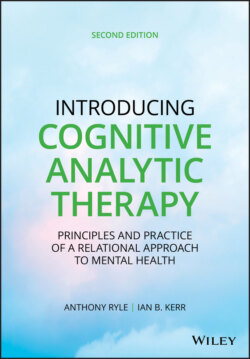Читать книгу Introducing Cognitive Analytic Therapy - Anthony Ryle - Страница 24
CAT Has Applications In Many Clinical and Other Settings
ОглавлениеOverall, CAT by now offers, in our view, a robust, comprehensive framework within which various helpful clinical treatments may be offered, and which also offers a means of re‐conceptualizing many challenging problems (e.g., dementia, the “difficult” patient, “personality disorder,” psychosomatic disorders, psychosis, and so forth; see Chapters 2 and 9). We note that, inevitably, further major conceptual and clinical challenges exist for CAT, as for any other current model, some of which are addressed elsewhere in the book. This book is primarily addressed to those in training or already working therapeutically with psychologically distressed or disturbed individuals, but also to those colleagues who, while not “doing therapy,” have important clinical and other (e.g., managerial, judicial) responsibilities. We believe that psychological and relational understandings should play a larger part than is now the case throughout health services, such as the NHS, and beyond. This would include management of groups such as psychiatric patients with major mental disorders, forensic patients, the “mentally handicapped” or “intellectually disabled,” and also, for example, in schools and in other social settings (see Chapter 9). We believe that psychotherapists should ideally play a central role in supporting and training staff in these fields. In all these fields experience is accumulating of applying CAT, and the model appears to be accessible and useful to many patients and clinical staff (see Chapters 9 and 11). While both psychodynamic therapies and cognitive therapy have contributed historically to these fields, neither, in our view, adequately conceptualizes or mobilizes the therapeutic power of the relationship between patients and those looking after them in a way that is clear, structured, and, above all, clinically helpful. Importantly, CAT also appears to offer an effective, relationally underpinned, structured, and containing framework within which health professionals frequently feel empowered and “liberated” to enact, properly and safely, the care and compassion that most bring to their work. For many this may be repressed and disallowed in many present day, commodified, and highly defensive health care systems (see Lees, 2016; Lowenthal, 2015). Nonetheless, these qualities are recognized to lie at the core of any effective health (or social) care (see Youngson, 2012). We believe that CAT has a major generic contribution to make in these areas, offering a distinct, coherent, and teachable model of social and interpersonal development, interaction, and well‐being that can enable individuals, staff groups, and services to respond helpfully, rather than react collusively, to their patients, and which may also have important applications outside clinical practice (see Chapters 9 and 11).
